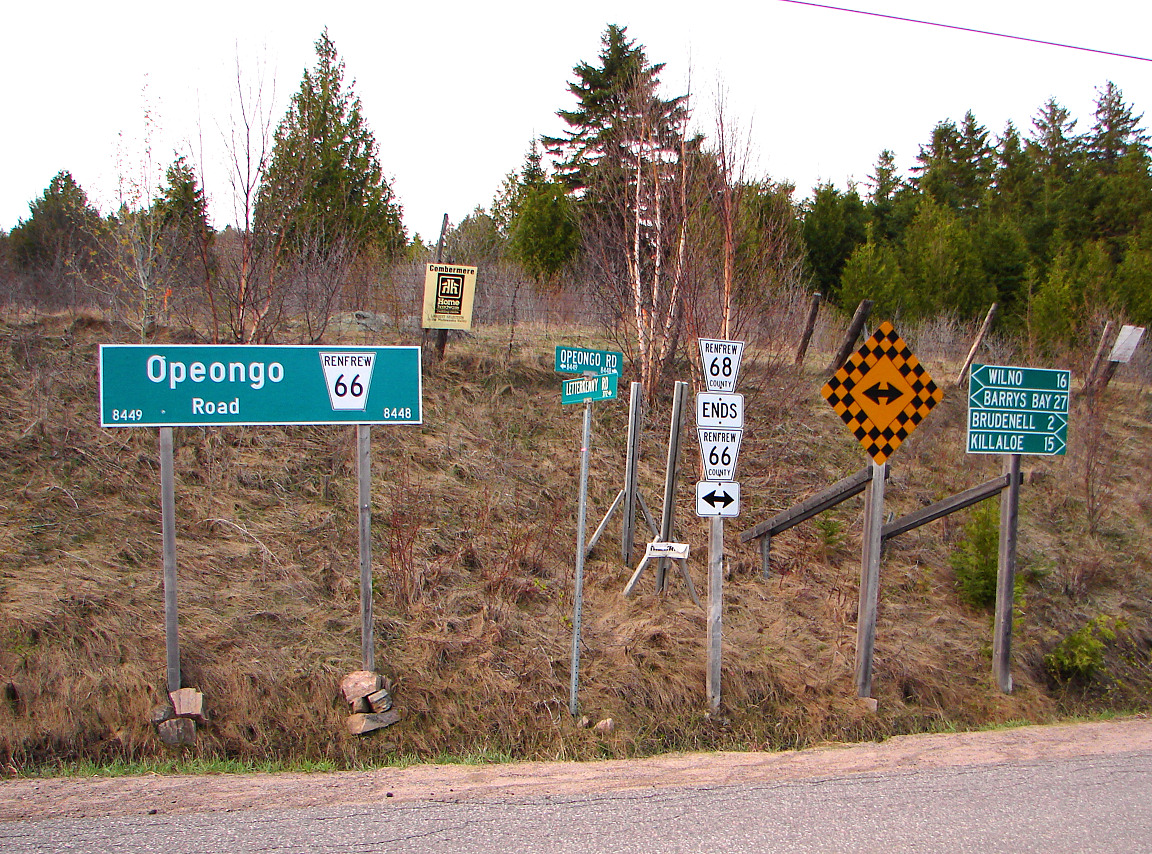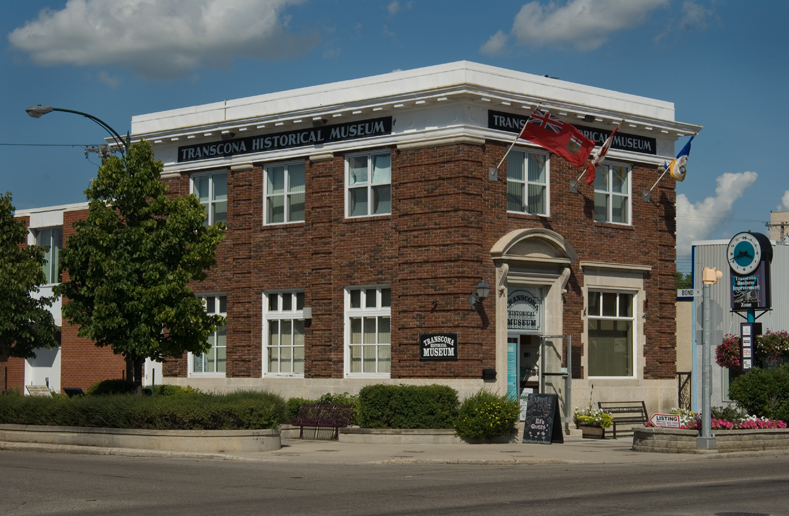|
Winnipeg Route 20
Route 20 (known locally as Lagimodière Boulevard) is a major north-south arterial route in the city of Winnipeg, Manitoba, Canada. It is also part of Manitoba Highway 59, the only Provincial Trunk Highway (other than the Trans-Canada Highway) that crosses through the city. Route description At about , it is one of the longest roads in the city. It begins in the northeast, running through the suburb of North Kildonan before becoming the boundary between the suburbs of East Kildonan and Transcona. South of the CNR Redditt line, it enters the eastern section of St. Boniface, passing by the CNR Symington Yards and the Royal Canadian Mint before crossing the Perimeter Highway and leaving the city in the extreme southern part of St. Boniface. Route 20 maintains expressway standards through Winnipeg, generally as a 4-lane divided route, and has an 80 km/h (50 mph) speed limit for the most part, except for a brief section in the north end at Regent Avenue where the speed ... [...More Info...] [...Related Items...] OR: [Wikipedia] [Google] [Baidu] |
Winnipeg
Winnipeg () is the capital and largest city of the province of Manitoba in Canada. It is centred on the confluence of the Red and Assiniboine rivers, near the longitudinal centre of North America. , Winnipeg had a city population of 749,607 and a metropolitan population of 834,678, making it the sixth-largest city, and eighth-largest metropolitan area in Canada. The city is named after the nearby Lake Winnipeg; the name comes from the Western Cree words for "muddy water" - “winipīhk”. The region was a trading centre for Indigenous peoples long before the arrival of Europeans; it is the traditional territory of the Anishinabe (Ojibway), Ininew (Cree), Oji-Cree, Dene, and Dakota, and is the birthplace of the Métis Nation. French traders built the first fort on the site in 1738. A settlement was later founded by the Selkirk settlers of the Red River Colony in 1812, the nucleus of which was incorporated as the City of Winnipeg in 1873. Being far inland, the local cl ... [...More Info...] [...Related Items...] OR: [Wikipedia] [Google] [Baidu] |
Saint Boniface, Manitoba
St-Boniface (or Saint-Boniface) is a city ward and neighbourhood in Winnipeg. Along with being the centre of the Franco-Manitoban community, it ranks as the largest francophone community in Western Canada. It features such landmarks as the St. Boniface Cathedral, Boulevard Provencher, the Provencher Bridge, Esplanade Riel, St. Boniface Hospital, the Université de Saint-Boniface, and the Royal Canadian Mint. The area covers east-central and southeast Winnipeg, including ('Old St. Boniface'), and consists of the neighbourhoods of Norwood West, Norwood East, Windsor Park, Niakwa Park, Niakwa Place, Southdale, Southland Park, Royalwood, Sage Creek, and Island Lakes, among others, plus a large industrial area. The ward is represented by Matt Allard, a member of Winnipeg City Council, and also corresponds to the neighbourhood clusters of St-Boniface East and West. The population was 58,520 according to the Canada 2016 Census. History Succeeding cultures of indigenous peoples ... [...More Info...] [...Related Items...] OR: [Wikipedia] [Google] [Baidu] |
Jean-Baptiste Lagimodière
Jean-Baptiste Lagimodière (25 December 1778 in Trois-Rivières, Quebec – 7 September 1855 in Saint-Boniface, Manitoba) was a French-Canadian trapper employed in the fur trade by the Hudson's Bay Company in Rupert's Land. Lagimodière is noted both as the grandfather of Métis leader Louis Riel, and as the husband of Marie-Anne Gaboury, the first woman of European descent to travel to and settle in western Canada. The Lagimodières were also, in 1812, the first settlers at the Red River Colony near modern Winnipeg, Manitoba. He is portrayed by John Juliani in the 1978 film ''Marie-Anne''. The Winnipeg section of Manitoba Highway 59, known formally as Winnipeg Route 20 Route 20 (known locally as Lagimodière Boulevard) is a major north-south arterial route in the city of Winnipeg, Manitoba, Canada. It is also part of Manitoba Highway 59, the only Provincial Trunk Highway (other than the Trans-Canada Highway) th ..., in the eastern part of the city, is named Lagimodi ... [...More Info...] [...Related Items...] OR: [Wikipedia] [Google] [Baidu] |
Dawson Road
The colonization roads were created during the 1840s and 1850s to open up or provide access to areas in Central and Eastern Ontario for settlement and agricultural development. The colonization roads were used by settlers to lead them toward areas for settlement, much like modern-day highways. History The colonization roads of the 1840s and 1850s were preceded by other government-sponsored road programmes going back to the period immediately after the American Revolutionary War. One early road was cut through the geographic Beverley Township from Ancaster westward toward the Grand River by two Englishmen named Ward and Smith in 1799–1800. This allowed European settlers to access the northern part of the Grand River Valley. During and after the War of 1812, government spending on roads in Upper Canada (present-day Ontario) increased significantly, leading to the improvement and extension of a number of roads. Roads into the interior were still not plentiful, however. By thi ... [...More Info...] [...Related Items...] OR: [Wikipedia] [Google] [Baidu] |
Winnipeg Route 37
Route 37 is a major east-west arterial route in Winnipeg, Manitoba which connects the suburbs of Transcona and Elmwood with the downtown core. Route description The official route begins on Redwood Avenue at that road's intersection with Salter Street in the city's North End. Route 37 passes over the Redwood Bridge and enters the suburb of Elmwood as Hespeler Avenue, until it meets Henderson Highway. Eastbound traffic bears south on Henderson before bearing right to follow Riverton Avenue, which curves into an eastbound Midwinter Avenue. After a short jog south on Levis Street, it joins Nairn Avenue. Westbound traffic turns north off Nairn onto Watt Street before turning west onto Levis, then Johnson Avenue West. Meeting Henderson, route 37 heads south three blocks before bearing west on Hespeler Avenue. Route 37 continues over the CP main line towards Transcona as Nairn Avenue, Regent Avenue West, Pandora Avenue West, and Pandora Avenue East. It turns southbound on Ravenhurs ... [...More Info...] [...Related Items...] OR: [Wikipedia] [Google] [Baidu] |
Limited-access Road
A limited-access road, known by various terms worldwide, including limited-access highway, dual-carriageway, expressway, limited access freeway, and partial controlled access highway, is a highway or arterial road for high-speed traffic which has many or most characteristics of a controlled-access highway (also known as a ''freeway'' or ''motorway''), including limited or no access to adjacent property, some degree of Dual carriageway, separation of opposing traffic flow, use of grade separated Interchange (road), interchanges to some extent, prohibition of slow modes of transport, such as bicycles, Working animal, (draught) horses, or self-propelled agricultural machines; and very few or no intersection (road), intersecting cross-streets or level crossings. The degree of isolation from local traffic allowed varies between countries and regions. The precise definition of these terms varies by jurisdiction.''Manual on Uniform Traffic Control Devices''Section 1A.13 Definitions of ... [...More Info...] [...Related Items...] OR: [Wikipedia] [Google] [Baidu] |
Manitoba Highway 100
100 or one hundred (Roman numeral: C) is the natural number following 99 and preceding 101. In medieval contexts, it may be described as the short hundred or five score in order to differentiate the English and Germanic use of "hundred" to describe the long hundred of six score or 120. In mathematics 100 is the square of 10 (in scientific notation it is written as 102). The standard SI prefix for a hundred is " hecto-". 100 is the basis of percentages (''per cent'' meaning "per hundred" in Latin), with 100% being a full amount. 100 is a Harshad number in decimal, and also in base-four, a base in-which it is also a self-descriptive number. 100 is the sum of the first nine prime numbers, from 2 through 23. It is also divisible by the number of primes below it, 25. 100 cannot be expressed as the difference between any integer and the total of coprimes below it, making it a noncototient. 100 has a reduced totient of 20, and an Euler totient of 40. A totient value ... [...More Info...] [...Related Items...] OR: [Wikipedia] [Google] [Baidu] |
Royal Canadian Mint
}) is the mint of Canada and a Crown corporation, operating under the ''Royal Canadian Mint Act''. The shares of the Mint are held in trust for the Crown in right of Canada. The Mint produces all of Canada's circulation coins, and manufactures circulation coins on behalf of other nations. The Mint also designs and manufactures precious and base metal collector coins; gold, silver, palladium, and platinum bullion coins; medals, as well as medallions and tokens. It further offers gold and silver refinery and assay services. The Mint serves the public's interest but is also mandated to operate "in anticipation of profit" (i.e., to function in a commercial manner without relying on taxpayer support to fund its operations). Like private-sector companies, the Mint has a board of directors consisting of a chair, the president and CEO of the Mint, and eight other directors. Traditionally, the president of the Royal Canadian Mint is known as the Master of the Mint, currently Marie Le ... [...More Info...] [...Related Items...] OR: [Wikipedia] [Google] [Baidu] |
Canadian National Railway
The Canadian National Railway Company (french: Compagnie des chemins de fer nationaux du Canada) is a Canadian Class I freight railway headquartered in Montreal, Quebec, which serves Canada and the Midwestern and Southern United States. CN is Canada's largest railway, in terms of both revenue and the physical size of its rail network, spanning Canada from the Atlantic coast in Nova Scotia to the Pacific coast in British Columbia across approximately of track. In the late 20th century, CN gained extensive capacity in the United States by taking over such railroads as the Illinois Central. CN is a public company with 22,600 employees, and it has a market cap of approximately CA$90 billion. CN was government-owned, having been a Canadian Crown corporation from its founding in 1919 until being privatized in 1995. , Bill Gates is the largest single shareholder of CN stock, owning a 14.2% interest through Cascade Investment and his own Bill and Melinda Gates Foundation. Fr ... [...More Info...] [...Related Items...] OR: [Wikipedia] [Google] [Baidu] |
Manitoba Highway 59
Provincial Trunk Highway 59 (PTH 59) is a major provincial highway in the Canadian province of Manitoba. It runs from the Lancaster-Tolstoi Border Crossing (where it meets with U.S. Highway 59), through the city of Winnipeg, north to 8th Avenue in Victoria Beach on Lake Winnipeg. Route description PTH 59 is a four-lane at-grade expressway from Provincial Road 210 south of Île-des-Chênes, through Winnipeg, to the Brokenhead Ojibway Nation, except for a two-kilometre section of six-lane road between the North Perimeter Highway (PTH 101) and Provincial Road 202. The remainder of PTH 59 is a two-lane highway except within the communities of St. Pierre-Jolys and St. Malo. PTH 59 coincides with City Route 20 (Lagimodière Boulevard) as it runs through the eastern part of the Winnipeg. North of the city, PTH 59 is the main route to Grand Beach and the eastern side of Lake Winnipeg and part of the La Vérendrye Trail. To the south, PTH 59 is effectively the modern-day suc ... [...More Info...] [...Related Items...] OR: [Wikipedia] [Google] [Baidu] |
Transcona, Winnipeg
Transcona is a ward and suburb of Winnipeg, Manitoba, located about east of the downtown area. Until 1972, it was a separate municipality, having been incorporated first as the Town of Transcona on 6 April 1912 and then as the City of Transcona in 1961. The first Council for the Town of Transcona met in 1912, with Colin J. E. Maxwell as mayor; and the first Council for the City of Transcona met on 19 June 1961, with T. F. Copeland as mayor. Today, the ward is represented by a member of Winnipeg City Council, and the suburb is part of the Transcona neighbourhood cluster—composed of much larger boundaries including large areas that were part of the Municipality of North Kildonan, and much of the area west of Plessis. It is primarily a working-class residential area with some light industry. History Beginning in 1835, the area now known as Transcona was administered by the Council of Assiniboia until 1870, when the Province of Manitoba was created and took jurisdictio ... [...More Info...] [...Related Items...] OR: [Wikipedia] [Google] [Baidu] |
East Kildonan, Winnipeg
East Kildonan is a primarily residential community in northeast Winnipeg, Manitoba, Canada. Commonly known by its initials EK, the suburb has a population of approximately 35,800 as of the 2016 Census. East Kildonan is bounded from the Red River on the west, to Panet Road, north of Blantyre Avenue, and the Canadian Pacific Railway Marconi tracks (removed in 2006) on the east; and the lane between Larsen and Harbison Avenues on the south, to Oakland Avenue on the north. It is mainly a working- and middle-class community, though there are poorer pockets south of Munroe Avenue and more affluent areas along the Red River and west of Henderson Highway, East Kildonan's major thoroughfare. There is a small industrial area located between Watt Street and the CPR tracks. East Kildonan is considered part of the western half of the River East community area. It is made up of the neighbourhoods of Munroe, Morse Place, Rossmere, and Fraser's Grove. History The name "Kildonan" origi ... [...More Info...] [...Related Items...] OR: [Wikipedia] [Google] [Baidu] |
.png)






